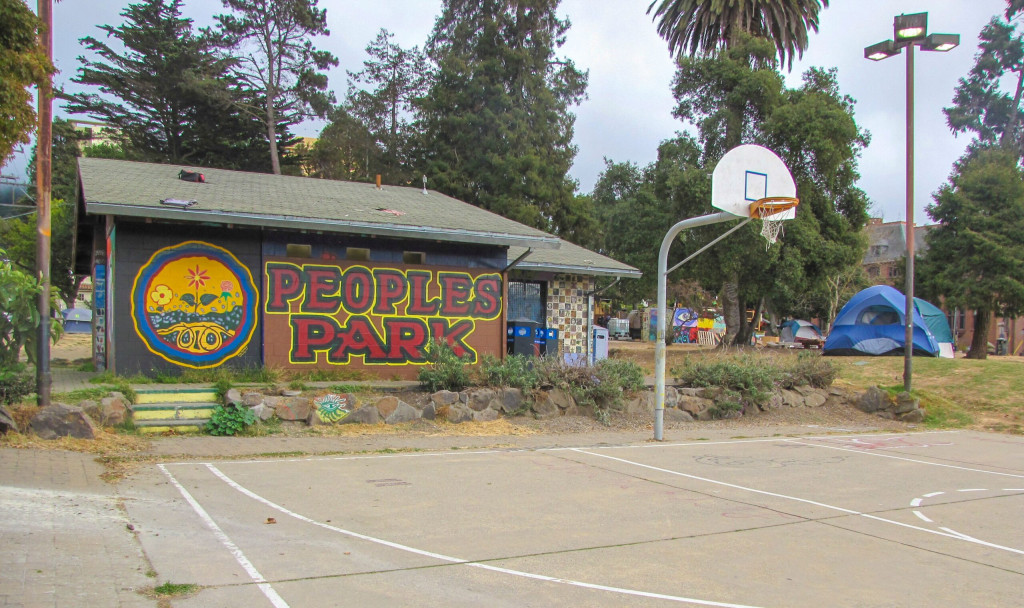People’s Park has had a rich and diverse history since the 1960s. Over the years, it has seen much change, as well as a decrease in popularity. Now, with the University of California (UC), Berkeley’s plans to build student housing atop it, we may be the generation to see the last step in the park’s decline.
Harvey Smith, president of the People’s Park Historic District Advocacy Group, told the Jacket about People’s Park’s tumultuous past.
As a Berkeley native, he remembers when the park was not a park but a residential area with houses. When UC Berkeley bought the plot of land that would become People’s Park, they cleared the lot of buildings, then did nothing for a while. During 1969, the dirt lot which remained unused and empty, was transformed by thousands of volunteers who flocked to the lot and rebuilt it with sod, flowers, and free speech.
Over the years, People’s Park has served as a home for many Bay Area natives, specifically Berkeley’s houseless population. June Nelson, a member of the People’s Park Committee, said that “[The park] means a lot of different things to different people.” With the help of this committee, it has continued to be a center for mutual aid and cultivating community in Berkeley. Aside from the green space and the history, “the community is what makes the park,” Nelson stated. Some people use the park as a temporary living space, but “a lot of people call it their home,” they said. An interesting feature Nelson explained was the norms and social constructs they observed while volunteering there. They said that these precedents are what make People’s Park so diverse and dynamic; it offers a safe space for all kinds of people who seek refuge, whether it is just for a short period of time or a more permanent home.
In recent years, however, UC Berkeley has been toying with the idea of building student housing over the park. This idea has caused controversy throughout communities in Berkeley, and the People’s Park Historic District Advocacy Group have been working hard to get the university to change its mind. One issue the organization found with the plan to build over the site was the loss of historical locations. There are many historic architectural sites near the park that would be lost with this new construction. People’s Park itself is a designated City of Berkeley Landmark, and is surrounded by eleven landmarked properties.
Smith also explained that “the beginning and end of homelessness is not People’s Park,” as UC Berkeley seems to think it is. “We like to decouple the idea of homelessness from the park, because homelessness is an issue that’s very much with us in the Bay Area,” Smith said.
Both the People’s Park Historic District Advocacy Group and the People’s Park Committee have suggested that the university build their student housing on other land. In total, UC Berkeley owns nine plots of land they could build on, but they are only considering two, one of them being People’s Park. Smith argued that the university picked the two worst options in terms of spacing, as the south side of Berkeley is already densely populated. His group is advocating for the preservation of open, green spaces in South Berkeley, People’s Park being a very important part of that.
If UC Berkeley doesn’t build on the land, the Historic District Advocacy Group has their own plans. They want to revamp the park to once again be a center of community. Smith used Civic Center by Berkeley High School as an example, and discussed ideas for redoing the sidewalk next to People’s Park with historic plaques, regrowing the native plant garden, and doing some work on the grass to attract more visitors.
Additionally, they advocate for the preservation of the park for the sake of the many houseless people who call it their home. They plan to continue their mutual aid work as well as cultivate the pre-existing community surrounding the park historically.
The UC Berkeley Regents voted with an overwhelming majority to begin construction at People’s Park, which will only proceed if the four lawsuits in protest of this do not go through. We will observe the progress of these lawsuits in the coming months and witness the evolution of People's Park.






